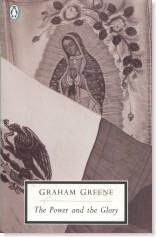In Graham Greene’s novel, The Power and Glory, the priest, known only as the “whiskey priest,” does not find his salvation…at least not in any way that would be recognized by his church. He is, as he himself says, a bad priest, given to drink, slipshod at his clerical tasks, and somewhere along the way he fathered a child.
There had been a time he was considered a good priest. A time when he believed it himself. And if not quite believing it, believing he could aspire to such as long as stayed within the structures of the church with his piety out front and hardened around him. 
But it’s when he’s on the out, living within the givenness of his “sin,” that God meets him. And it’s in a soiled and stinking and overcrowded prison cell, where he finds beauty and his own humanity. Here in the company of his own, the weakest kind of flesh, his heart swells with the compassion of Christ. Swells even for the immensely pious woman who counts herself far above the fornicators, thieves, drunkards and beggars that share the cell.
This, then, was the “whiskey priest’s” revelation: “When you visualized a man or woman carefully, you could always begin to feel pity…that was a quality God’s image carried with it…when you saw the lines at the corner of the eyes, the shape of the mouth and how the hair grew, it was impossible to hate. Hate was just a failure of imagination.”
- The prison scene is not only one of the great pieces of English literature, it is a scene of profound theological depth.
- Greene published this book in 1940. In 1954 a ban was placed upon the book by the Vatican.

I wonder if when ‘big systems’ need to ban things it is an indication of a truth that is pricking at their hearts but which they need to quickly repress or their whole system will fall apart. Seems to me that something banned is always worth looking at.